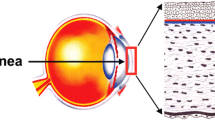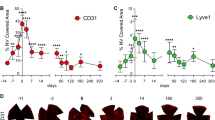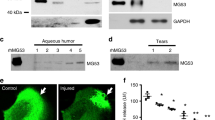Abstract
Lumican and keratocan are members of the small leucine-rich proteoglycan (SLRP) family, and are the major keratan sulfate (KS) proteoglycans in corneal stroma. Both lumican and keratocan are essential for normal cornea morphogenesis during embryonic development and maintenance of corneal topography in adults. This is attributed to their bi-functional characteristic (protein moiety binding collagen fibrils to regulate collagen fibril diameters, and highly charged glycosaminoglycan (GAG) chains extending out to regulate interfibrillar spacings) that contributes to their regulatory role in extracellular matrix assembly. The absence of lumican leads to formation of cloudy corneas in homozygous knockout mice due to altered collagenous matrix characterized by larger fibril diameters and disorganized fibril spacing. In contrast, keratocan knockout mice exhibit thin but clear cornea with insignificant alteration of stromal collaegenous matrix. Mutations of keratocan cause cornea plana in human, which is often associated with glaucoma. These observations suggest that lumican and keratocan have different roles in regulating formation of stromal extracellular matrix. Experimental evidence indicates that lumican may have additional biological functions, such as modulation of cell migration and epithelium-mesenchyme transition in wound healing and tumorgenesis, besides regulating collagen fibrillogenesis. Published in 2003.
Similar content being viewed by others
References
Linsenmayer TF, Fitch JM, Birk DE, Heterotypic collagen fibrils and stabilizing collagens. Controlling elements in corneal morphogenesis? [Review], Annals of the New York Academy of Sciences 1990;580:143-60 580, 143–60 (1990).
Hay ED, Development of the verterate cornea, Int Rev Cytol 63, 263–322 (1980).
Doane KJ, Babiarz JP, Fitch JM, Linsenmayer TF, Birk DE, Collagen fibril assembly by corneal fibroblasts in three-dimensional collagen gel cultures: Small-diameter heterotypic fibrils are deposited in the absence of keratan sulfate proteoglycan, Exp Cell Res 202, 113–24 (1992).
Hahn RA, Birk DE, beta-D xyloside alters dermatan sulfate proteoglycan synthesis and the organization of the developing avian corneal stroma, Development 115, 383–93 (1992).
Rada JA, Cornuet PK, Hassell JR, Regulation of corneal collagen fibrillogenesis in vitro by corneal proteoglycan (lumican and decorin) core proteins, Exp Eye Res 56, 635–48 (1993).
Weber IT, Harrison RW, Iozzo RV, Model structure of decorin and implications for collagen fibrillogenesis, J Biol Chem 271, 31767–70 (1996).
Scott JE, Proteodermatan and proteokeratan sulfate (decorin, lumican/fibromodulin) proteins are horseshoe shaped. Implications for their interactions with collagen, Biochemistry 35, 8795–9 (1996).
Bettelheim FA, Plessy B, The hydration of proteoglycans of bovine cornea, Biochim Biophys Acta 381, 203–14 (1975).
Rawe IM, Tuft SJ, Meek KM, Proteoglycan and collagen morphology in superficially scarred rabbit cornea, Histochem J 24, 311–8 (1992).
Hassell JR, Cintron C, Kublin C, Newsome DA, Proteoglycan changes during restoration of transparency in corneal scars, Archives of Biochemistry & Biophysics 1983 Apr 15;222(2):362- 9 222, 362–9 (1983).
Funderburgh JL, Funderburgh ML, Hevelone ND, Stech ME, Justice MJ, Liu CY, Kao WW, Conrad GW, Sequence, molecular properties, and chromosomal mapping of mouse lumican, Invest Ophthalmol Vis Sci 36, 2296–303 (1995).
Grover J, Chen XN, Korenberg JR, Roughley PJ, The human lumican gene. Organization, chromosomal location, and expression in articular cartilage, J Biol Chem 270, 21942–9 (1995).
Prockop DJ, Kivirriko KI, Collagens: Molecular biology, diseases, and potentials for therapy, Annu Rev Biochem 64, 403–34 (1995).
Blochberger TC, Vergnes JP, Hempel J, Hassell JR, cDNA to chick lumican (corneal keratan sulfate proteoglycan) reveals homology to the small interstitial proteoglycan gene family and expression in muscle and intestine, J Biol Chem 267, 347–52 (1992).
Cornuet PK, Blochberger TC, Hassell JR, Molecular polymorphism of lumican during corneal development, Invest Ophthalmol Vis Sci 35, 870–7 (1994).
Zhan Q, Burrows R, Cintron C, Cloning and in situ hybridization of rabbit decorin in corneal tissues, Invest Ophthalmol Vis Sci 36, 206–15 (1995).
Funderburgh JL, Conrad GW, Isoforms of corneal keratan sulfate proteoglycan, J Biol Chem 265, 8297–303 (1990).
Funderburgh JL, Funderburgh ML, Mann MM, Conrad GW, Physical and biological properties of keratan sulphate proteoglycan. [Review], Biochem Soc Trans 19, 871–6 (1991).
Funderburgh JL, Funderburgh ML, Brown SJ, Vergnes JP, Hassell JR, Mann MM, Conrad GW, Sequence and structural implications of a bovine corneal keratan sulfate proteoglycan core protein. Protein 37B represents bovine lumican and proteins 37A and 25 are unique, J Biol Chem 268, 11874–80 (1993).
Funderburgh JL, Corpuz LM, Roth MR, Funderburgh ML, Tasheva ES, Conrad GW, Mimecan, the 25-kDa corneal keratan sulfate proteoglycan, is a product of the gene producing osteoglycin, J Biol Chem 272, 28089–95 (1997).
Funderburgh JL, Funderburgh ML, Mann MM, Conrad GW, Unique glycosylation of three keratan sulfate proteoglycan isoforms, J Biol Chem 266, 14226–31 (1991).
Iozzo R, Murdoch AD, Proteoglycans of the extracellular environment: Clues from the gene and protein side offer novel perspective in molecular diversity and function, FASEB J 10, 598–614 (1996).
Funderburgh JL, Conrad GW, Detection and purification of corneal keratan sulphate proteoglycan from non-corneal tissues. In Keratan Sulphate.Chemistry, Biology, Chemical Pathology, edited by Greiling H, Scott JE (London: The Biochemical Society, 1989), pp. 39–52.
Kobe B, Deisenhofer J, Proteins with leucine-rich repeats. [Review], Current Opinion in Structural Biology 5, 409–16 (1995).
Matsushima N, Ohyanagi T, Tanaka T, Kretsinger RH, Supermotifs and evolution of tandem leucine-rich repeats within the small proteoglycans-Biglycan, decorin, lumican, fibromodulin, PRELP, keratocan, osteoadherin, epiphycan, and osteoglycin, Proteins 38, 210–25 (2000).
Chakravarti S, Magnuson T, Lass JH, Jepsen KJ, LaMantia C, Carroll H, Lumican regulates collagen fibril assembly: Skin fragility and corneal opacity in the absence of lumican, J Cell Biol 141, 1277–86 (1998).
Saika S, Shiraishi A, Saika S, Liu C-Y, Funderburgh JL, Kao CWC, Converse RL, Kao WWY, Role of lumican in the corneal epithelium during wound healing, J Biol Chem 275, 2607–12 (2000).
Iozzo RV, The family of the small leucine-rich proteoglycans: Key regulators of matrix assembly and cellular growth. [Review] [162 refs], Critical Reviews in Biochemistry & Molecular Biology 32, 141–74 (1997).
Iozzo RV, The biology of the small leucine-rich proteoglycans. Functional network of interactive proteins, J Biol Chem 274, 18843–6 (1999).
Oldberg A, Antonsson P, Moses J, Fransson LA, Amino-terminal deletions in the decorin core protein leads to the biosynthesis of proteoglycans with shorter glycosaminoglycan chains, FEBS Lett 386, 29–32 (1996).
Oldberg A, Antonsson P, Lindblom K, Heinegard D, A collagenbinding 59-kd protein (fibromodulin) is structurally related to the small interstitial proteoglycans PG-S1 and PG-S2 (decorin), EMBO J 8, 2601–4 (1989).
Corpuz LM, Funderburgh JL, Funderburgh ML, Bottomley GS, Prakash S, Conrad GW, Molecular cloning and tissue distribution of keratocan. Bovine corneal keratan sulfate proteoglycan 37A, J Biol Chem 271, 9759–63 (1996).
Otvos LJ, Cappelletto B, Varga I, Wade JD, Xiang ZQ, Kaiser K, Stephens LJ, Ertl HC, The effects of post-translational sidechain modifications on the stimulatory activity, serum stability and conformation of synthetic peptides carrying T helper cell epitopes, Biochim Biophys Acta 1313, 11–9 (1996).
Antonsson P, Heinegard D, Oldberg A, Posttranslational modifi-cations of fibromodulin, J Biol Chem 266, 16859–61 (1991).
Gendron RL, Liu CY, Paradis H, Adams LC, Kao WW, MK/T-1, an immortalized fibroblast cell line derived using cultures of mouse corneal stroma, Mol Vis 7, 107–13 (2001).
Carlson EC, Mamiya K, Liu CY, Gendron RL, Birk DE, Funderburgh JL, Kao WW, Role of 41Cys in the N-terminal domain of lumican in ex vivo collagen fibrillogenesis by cultured corneal stromal cells, Biochem J Pt, 369, 461–68 (2003).
Patthy L, Detecting distant homologies of mosaic proteins. Analysis of the sequences of thrombomodulin, thrombospondin complement components C9, C8 alpha and C8 beta, vitronectin and plasma cell membrane glycoprotein PC-1, J Mol Biol 202, 689–96 (1988).
Scott PG, Winterbottom N, Dodd CM, Edwards E, Pearson CH, A role for disulphide bridges in the protein core in the interaction of proteodermatan sulphate and collagen, Biochem Biophys Res Commun 138, 1348–54 (1986).
Hedbom E, Heinegard D, Binding of fibromodulin and decorin to separate sites on fibrillar collagens, J Biol Chem 265, 27307–12 (1993).
Marchant JK, Hahn RA, Linsenmayer TF, Birk DE, Reduction of type V collagen using a dominant-negative strategy alters the regulation of fibrillogenesis and results in the loss of corneal-specific fibril morphology, J Cell Biol 135, 1415–26 (1996).
Svensson L, Heinegard D, Oldberg A, Decorin-binding sites for collagen type I are mainly located in leucine-rich repeats 4-5, J Biol Chem 270, 20712–6 (1995).
Gu J, Nakayama Y, Nagai K, Wada Y, The production and purifi-cation of functional decorin in a baculovirus system, Biochemical & Biophysical Research Communications 232, 91–5 (1997).
Scott JE, Extracellular matrix, supramolecular organisation and shape. [Review], J Anat 187, 259–69 (1995).
Takahashi T, Cho HI, Kublin CL, Cintron C, Keratan sulfate and dermatan sulfate proteoglycans associate with type VI collagen in fetal rabbit cornea, J Histochem Cytochem 41, 1447–57 (1993).
Liu CY, Shiraishi A, Kao CW, Converse RL, Funderburgh JL, Corpuz LM, Conrad GW, Kao WW, The cloning of mouse keratocan cDNA and genomic DNA and the characterization of its expression during eye development, J Biol Chem 273, 22584–8 (1998).
Bengtsson E, Neame PJ, Heinegard D, Sommarin Y, The primary structure of a basic leucine-rich repeat protein, PRELP, found in connective tissues, J Biol Chem 270, 25639–44 (1995).
Torok MA, Evans SA, Marcum JA, cDNA sequence for bovine biglycan (PGI) protein core, Biochim Biophys Acta 1173, 81–4 (1993).
Hedbom E, Heinegard D, Interaction of a 59-kDa connective tissue matrix protein with collagen I and collagen II, J Biol Chem 264, 6898–905 (1989).
Hedlund H, Mengarelli-Widholm S, Heinegard D, Reinholt FP, Svensson O, Fibromodulin distribution and association with collagen, Matrix Biol 14, 227–32 (1994).
Ying S, Shiraishi A, Kao CW, Converse RL, Funderburgh JL, Swiergiel J, Roth MR, Conrad GW, Kao WW, Characterization and expression of the mouse lumican gene, J Biol Chem 272, 30306–13 (1997).
Chakravarti S, Stallings RL, SundarRaj N, Cornuet PK, Hassell JR, Primary structure of human lumican (keratan sulfate proteoglycan) and localization of the gene (LUM) to chromosome 12q21.3-q22, Genomics 27, 481–8 (1995).
Corpuz LM, Dunlevy JR, Hassell JR, Conrad AH, Conrad GW, Molecular cloning and relative tissue expression of decorin and lumican in embryonic quail cornea, Matrix Biol 19, 699–704 (2000).
Danielson KG, Siracusa LD, Donovan PJ, Iozzo RV, Decorin, epiphycan, and lumican genes are closely linked on murine Chromosome 10 and are deleted in lethal steel mutants, Mamm Genome 10, 201–3 (1999).
Hassell JR, Rada J, Cornuet P, Vergnes JP, Kinchington PR, Gene structure of chick lumican and identification of the first exon, Biochim Biophys Acta 1397, 119–25 (1998).
Dunlevy JR, Chakravarti S, Gyalzen P, Vergnes JP, Hassell JR, Cloning and chromosomal localization of mouse keratocan, a corneal keratan sulfate proteoglycan, Mamm Genome 9, 316–9 (1998).
Tasheva ES, Funderburgh JL, Corpuz LM, Conrad GW, Cloning, characterization and tissue-specific expression of the gene encoding bovine keratocan, a corneal keratan sulfate proteoglycan, Gene 218, 63–8 (1998).
Grover J, Liu CY, Kao WW, Roughley PJ, Analysis of the human lumican gene promoter, J Biol Chem 275, 40967–73 (2000).
Liu C, Arar H, Kao C, Kao WW, Identification of a 3.2 kb 5_-flanking region of the murine keratocan gene that directs betagalactosidase expression in the adult corneal stroma of transgenic mice, Gene 250, 85–96 (2000).
Rossi P, Karsenty G, Roberts AB, Roche NS, Sporn MB, De Crombrugghe B, A nuclear factor 1 binding site mediates the transcriptional activation of a type I collagen promoter by transforming growth factor-beta, Cell 52, 405–14 (1988).
Courtois SJ, Lafontaine DA, Lemaigre FP, Durviaux SM, Rousseau GG, Nuclear factor-I and activator protein-2 bind in a mutually exclusive way to overlapping promoter sequences and trans-activate the human growth hormone gene, Nucleic Acids Res 18, 57–64 (1990).
Keeton MR, Curriden SA, van Zonneveld AJ, Loskutoff DJ, Identification of regulatory sequences in the type 1 plasminogen activator inhibitor gene responsive to transforming growth factor beta, J Biol Chem 266, 23048–52 (1991).
Iozzo RV, Pillarisetti J, Sharma B, Murdoch AD, Danielson KG, Uitto J, Mauviel A, Structural and functional characterization of the human perlecan gene promoter. Transcriptional activation by transforming growth factor-beta via a nuclear factor 1-binding element, J Biol Chem 272, 5219–28 (1997).
Saika S, Saika S, Liu CY, Azhar M, Sanford LP, Doetschman T, Gendron RL, Kao CW, Kao WW, TGFbeta2 in Corneal Morphogenesis during Mouse Embryonic Development, Dev Biol 240, 419–32 (2001).
Chakravarti S, The cornea through the eyes of knockout mice, Exp Eye Res 73, 411–9 (2001).
Chakravarti S, Petroll WM, Hassell JR, Jester JV, Lass JH, Paul J, Birk DE, Corneal opacity in lumican-null mice: Defects in collagen fibril structure and packing in the posterior stroma, Invest Ophthalmol Vis Sci 41, 3365–73 (2000).
Jester JV, Ghee LY, Li J, Chakravarti S, Paul J, Petroll WM, Dwight CH, Measurement of corneal sublayer thickness and transparency in transgenic mice with altered corneal clarity using in vivo confocal microscopy, Vision Res 41, 1283–90 (2001).
Austin BA, Coulon C, Liu CY, Kao WW, Rada JA, Altered collagen fibril formation in the sclera of lumican-deficient mice, Invest Ophthalmol Vis Sci 43, 1695–701 (2002).
Pellegata NS, Dieguez-Lucena JL, Joensuu T, Lau S, Montgomery KT, Krahe R, Kivela T, Kucherlapati R, Forsius H, de la CA, Mutations in KERA, encoding keratocan, cause cornea plana, Nat Genet 25, 91–5 (2000).
Lehmann OJ, El ashry MF, Ebenezer ND, Ocaka L, Francis PJ, Wilkie SE, Patel RJ, Ficker L, Jordan T, Khaw PT, Bhattacharya SS, A novel keratocan mutation causing autosomal recessive cornea plana, Invest Ophthalmol Vis Sci 42, 3118–22 (2001).
Funderburgh JL, Cintron C, Covington HI, Conrad GW, Immunoanalysis of keratan sulfate proteoglycan from corneal scars, Invest Ophthalmol Vis Sci 29, 1116–24 (1988).
Funderburgh JL, Mitschler RR, Funderburgh ML, Roth MR, Chapes SK, Conrad GW, Macrophage receptors for lumican. A corneal keratan sulfate proteoglycan, Invest Ophthalmol Vis Sci 38, 1159–67 (1997).
Leygue E, Snell L, Dotzlaw H, Troup S, Hiller-Hitchcock T, Murphy LC, Roughley PJ, Watson PH, Lumican and decorin are differentially expressed in human breast carcinoma, J Pathol 192, 313–20 (2000).
Lu YP, Ishiwata T, Kawahara K, Watanabe M, Naito Z, Moriyama Y, Sugisaki Y, Asano G, Expression of lumican in human colorectal cancer cells, Pathol Int 52, 519–26 (2002).
Naito Z, Ishiwata T, Kurban G, Teduka K, Kawamoto Y, Kawahara K, Sugisaki Y, Expression and accumulation of lumican protein in uterine cervical cancer cells at the periphery of cancer nests, Int J Oncol 20, 943–8 (2002).
Ping LY, Ishiwata T, Asano G, Lumican expression in alpha cells of islets in pancreas and pancreatic cancer cells, J Pathol 196, 324–30 (2002).
Schaefer L, Grone HJ, Raslik I, Robenek H, Ugorcakova J, Budny S, Schaefer RM, Kresse H, Small proteoglycans of normal adult human kidney: Distinct expression patterns of decorin, biglycan, fibromodulin, and lumican [In Process Citation], Kidney Int 58, 1557–68 (2000).
Yoshioka N, Inoue H, Nakanishi K, Oka K, Yutsudo M, Yamashita A, Hakura A, Nojima H, Isolation of transformation suppressor genes by cDNAsubtraction: Lumican suppresses transformation induced by v-src and v-K-ras, J Virol 74, 1008–13 (2000).
Saika S, Miyamoto T, Tanaka S-I, Tanaka T, Ishida I, Ohnishi Y, Ooshima A, Ishiwata T, Asano G, Chikama T-I, Shiraishi A, Liu C-Y, Kao W-C, Kao WW-Y, Response of lens epithelial cells to injury: Role of lumican in epithelial-mesenchyme transition, Invest Ophthalmol Vis Sci 44, 2094–2102 (2003).
Author information
Authors and Affiliations
Corresponding author
Rights and permissions
About this article
Cite this article
Kao, W.WY., Liu, CY. Roles of lumican and keratocan on corneal transparency. Glycoconj J 19, 275–285 (2002). https://doi.org/10.1023/A:1025396316169
Issue Date:
DOI: https://doi.org/10.1023/A:1025396316169




